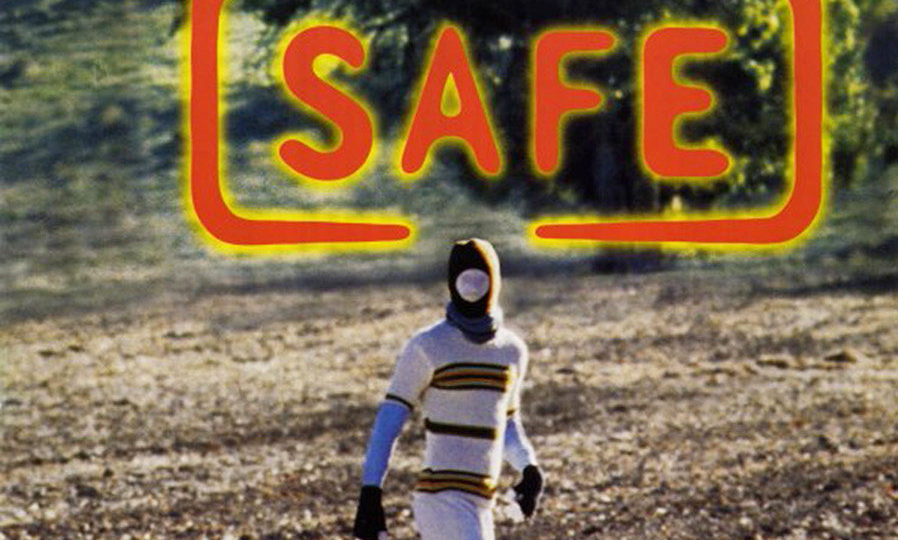
Safe (1995)
Through the years, American filmmaker Todd Haynes (Velvet Goldmine, Far From Heaven, I’m Not There, Carol) has created an amazing filmography with own characteristics. Through various genres, he has addressed the figure of “the outsider”- an idea that has permeated all of Haynes’ cinema, whose main theme is the conflict between the inside and the outside. This tension between the introversion and the extroversion is the cornerstone that shapes the behavior of Haynes’ characters, whose desires are almost subversive in the context in which they are created.
In 1995, Haynes directed Safe, an exceptional and highly enigmatic film, difficult to classify, rigorous in its form and construction, and also anarchic in its consequences. The story unfolds the life of Carol (Julianne Moore) and George White (Xander Berkeley), who are happily married and live with
live with George’s little son Rory in San Fernando Valley, California. Carol has an extremely relaxed socio-economic and wealthy position, she lives in a new, beautiful, spacious and comfortable house surrounded by a big garden.
Carol is introduced as a person who is completely lost. She is constantly disconnected from herself, her family and her surroundings. She just follows the routine of her upper middle class life, but never engages in anything with passion. Her emotions are contained. Carol describes herself as a housewife, and yet we never see her participating in any activity related to the organization of her house with real commitment. She is almost never at home, her routine oscillates between aerobics classes taken with a lack of enthusiasm, and daily lunches with her friends. She has no opinions of her own and constantly falls into manipulation.
Some small incidents – jokes, excessive smoke from a cargo truck, the purchase of furniture- begin to awake a strange illness inside her. One day, Carol suffers a coughing fit while driving, she begins to have migraines, lack of sex appetite, and extreme fatigue. Initially, these signs and symptoms appears to be normal, as her doctor insists that there’s nothing to worry about. But soon, Carol’s health starts to deteriorate brutally, as severing courses of nosebleeds and constant vomiting develop into anxiety attacks and disturbing seizures. The film gradually turns into an intense and mysterious psychological drama about an illness related to the lack of immunity against environmental pollution. Her unknown health
problem leads Carol to consult an allergist and a psychiatrist, without resulting in a specific diagnosis.
The failure of conventional medicine prompts her to contact a weird
character named Peter Dunning (Peter Friedman), a carrier of HIV. Peter turns out to be a demagogue and a charlatan, who practices alternative medicine and runs a village of chalets in the area of Wrenwood, New Mexico. He welcomes those affected by environmental or unknown diseases. He transmits confidence, serenity and hope; but Carol’s sickness and the affections of the community’s members don’t improve at all. Away from her husband who visits her regularly, Carol begins to deteriorate physically and mentally inside this disturbing and ‘safe’ village.
Todd Haynes crafts a thought-provoking and marvelous parable about the risks and irreversible damages that the progressive contamination of the planet can cause on human health. This film is also a complex and difficult analysis of the fears that plague the new societies. Starting from the vital anguish of a wealthy class woman and stable social position, Haynes dissects the steps of psychic self-destruction, based on a strange disease that causes psychosomatic reactions to pollution and chemicals of our era. The film also portrays a social scope on the diseases of the new millennium (anxiety, depression, AIDS, and most recently COVID-19/Coronavirus).
Throughout history, we have seen countless examples that involve fear of contact between people, as well as racism. In medieval Europe, Jews were blamed for the Black Plague that killed millions of people. In nineteenth-century New Orleans, black people were blamed for the Yellow Fever. In the 1980s, homosexuals were blamed for spreading AIDS. There’s a parallel between the fear that the white community in the San Fernando Valley in Safe has of immigrants who are “invading” the area (the subject is highlighted during a conversation during dinner about Rory’s duties), and the disease that this same community is causing Carol. The film is about people being afraid of others, and people being afraid of the unknown (technology, chemicals) and what the repercussions are on communities and big cities.
In technical matters, the film is very effective: in addition to the abundance of focused shots, the images constantly show us the interactions of the characters (especially Carol) with the environment that surrounds them: the viewer feels the pollution and disorder of an enormous city like Los Angeles. Then, images delve into those famous luxurious surroundings that are located in the suburbs of this city, offering us various spaces of hygiene and excessive artificiality in which Carol moves when her crises get worse. Ed Tomney‘s soundtrack also helps to craft a truly horrifying atmosphere, you can hear a great influence from the music of Angelo Badalamenti (Twin Peaks). The music is composed of dark, brooding synthesizers and tragic piano crescendos, as well as intoxicating vibraphone echoes. It all translates into a musical combination that will leave your mind intoxicated.
Safe is a much more intricate film than it seems. The story leaves responses to problems that are never fully defined as “real” or “fictitious”. It’s true that there is a huge percentage of population with autoimmune diseases like Systemic lupus erythematosus, Rheumatoid arthritis, Psoriasis, Myasthenia gravis), but what the film ends up questioning are the methods to fight these and all kinds of rare diseases. The real horror finally concentrates on the suffocating emptiness and monotony of Carol’s existence. Nevertheless, Safe doesn’t give immediate answers, but strongly resonates after it leaves the screen.
by Octavio Carbajal Gonzalez

Thank you,, Octavio, a typically inspiring read and another movie to add to to the list! Best wishes from Scotland.
So nice to see that you´re still tuned to my reviews, Mike !. Those are awesome words, thank you very much. Unmissable movie, very important topics and crucial messages.
All the best from Mexico.
Watched this last night after your recommendation, thanks a lot. Interesting movie with a very unsettling end. I found an interesting and irritating quote by Haynes: “Safe is on the side of the disease and not the cure, it (the disease) gives her a new identity”.
That´s awesome, happy to read this. Indeed, that ending is unsettling and thoughtful.
First, one of the hardest things in the world is learning to love yourself. Human beings are constantly looking for the “need of recognition” or searching for “the perfect love” to feel complete. For me, Carol didn´t build a true identity for herself, she just followed all the established rules of life, and in the end she felt highly disappointed with the result.
Our identity is a staggered sum of mind-blowing experiences; in this case, Carol´s disease was one of those kind of experiences, she never felt something like that before. That´s why “the new identity” theory is also valid.
Octavio,
Although I am not a fan of Todd Haynes, I appreciate how you are delving into wider historical/social contexts in this review: anxiety, AIDS, Black Plague, depression, environmental pollution, immigration and xenophobia, and the current Coronavirus crisis.
Thanks Mark, so glad you enjoyed the read. It was an amazing opportunity to talk about those new millennium diseases and to delve into some of humanity´s darkest socio-political and historical corners. The other day we were talking about “The Criterion Collection”, this movie is part of it.
Todd Haynes said on an interview that this movie was based on Michelangelo Antonioni´s “Red Desert” and Don DeLillo´s novel “White Noise”. There´s also Kubrickian resources and a Lynchian vibe.
Great film. And in times of self-isolation, Julian Moore doesn’t look so crazy anymore. A recommended follow-up watch is Todd Hayne’s “Dark Waters”, about a company that dumps toxic chemicals and poisons Virginia for decades.
Glad you enjoyed this film. I´m not a fan of Julianne Moore, but I can´t deny that she has done some amazing roles. Her performance here is remarkable. I also liked her roles in PTA´s “Magnolia”, Richard Glatzer´s “Forever Alice” and Haynes´ “Far From Heaven”.
In fact, I really like the first movies of Todd Haynes, his oldest stuff is not that impressive. I saw “Dark Waters” a few months ago, it was an “Ok” movie.
*His most recent movies aren´t as impressive as the older ones. Except for “Carol” (2015).
Great review Octavio. Timely, of course. I can’t help but think of the deeper sickness and dissatisfaction of a “civilization” without roots or pillars that ultimately give me a sense of community. Instead we focus on the superficial cures that lead us even further from a true path forward. It’s a sickness that was there before Coronavirus. And the cure goes much deeper the a quarantine.
Thanks for your valuable comment, Shawn. I support your idea of the “deeper sickness”, there has been this sense of dissatisfaction going around for a long time. The true path forward is something very subjective, but it´s absolutely necessary. I wonder if someday we will find that “deepest cure”.
mpactful film.
Amazing review, enjoyed your multi-layered thoughts. Just saw it a few months ago, still thinking about the ending..
*Impactful
Thanks for reading. Agree, the ending is captivating.
“The three words” that human beings desperately need to hear through their lives…
Outstanding film. All valid points in your review, but I think one aspect is missing: Moore’s character lives super healthy, just mineral water and health food, and it is also this neurotic behavior that leads to her pathological and crazy situation. While in the 80s and 90s that neurotic lifestyle was limited to the wealthy, it is not a question of status and money anymore.
Thank you for the comment. I also thought about the “healthy life” factor, but in the end I decided to discard it.
I think it’s clear from the start that Carol begins to deteriorate after the self-realization of how cyclical and boring her life is. The aspect you mention is valid, but (for me) it’s not one of the main etiologies of Carol’s disease.
A very timely topic. I’m intrigued to watch this after your great review, although I feel tortured by both, empty, Kubrickian lives & sadistic charlatans. Without having seen it, it strikes me that a film with such topics was made in 1995- that seems really ahead of its time. “Environmental illness” is an undeniable and ever progressing symptom of our ‘civilization’, and shows itself in countless ways. Love ‘Velvet Goldmine’ by Haynes, so I put this on my watchlist. Thanks for this recommendation!
Thank you for letting me spread the existence of this hidden gem, Saliha. I’ve been wanting to talk about it for a long time, you definitely can’t miss it. I agree with you, the movie is ahead of its time.
First, I never thought that COVID-19 would go this far. This health problem enlightens the undertones of the film, people are being forced to stay “safe” at their houses.
Apart from that, the topics of the movie are much more disturbing and relevant on today’s modern life. The rise of psychiatric and autoimmune diseases, racism, “humanitary organizations” that make profit out of people’s suffering, excessive pollution, etc. It just goes on and on, there’s a lot to unpack here !.